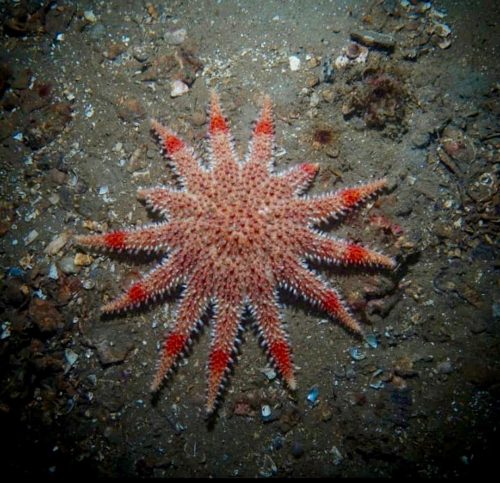Before arriving on the Isle of Arran, I didn’t fully comprehend just how much marine life there was in the Scotland’s waters, and how complex and diverse the underwater habitats really are.

Community organisations such as the Community of Arran Seabed Trust (COAST), with whom I have been working this summer, are working incredibly hard to protect the area from overfishing and damaging techniques such as scallop dredging and bottom trawling. COAST, together with the Blue Marine Foundation (BLUE), help to draft policy and to encourage the understanding and protection of these complex marine habitats and valuable species around Scotland’s coast. The more we understand an ecosystem, the more invested we will be in its protection.

During my time in Arran, I completed a collection of SCUBA diving surveys with my colleague William Notley from the University of York, focusing specifically on Lamlash Bay. These surveys were completed by underwater visual census techniques where one diver would record the species and habitats found within one metre each side of a 50 metre transect line, and the other would film the seabed with an underwater camera.

This work was completed within the no take zone (NTZ), where no fishing or shellfish collection is allowed; the surrounding South Arran Marine Protected Area (MPA), where bottom trawling, dredging and, in some places, creeling is prohibited; in further afield sites to the south of the island; and outside all protection, to the north, near Brodick Bay, where dredging is permitted.

I saw all sorts of creatures, my favourites being the curled octopus, clearly defined by its one row of suckers on each of its eight arms and the anemone hermit crab which has a symbiotic relationship with a cloak anemone which stays with the crab for life, providing growing space and security.
I spotted the small-spotted catshark, hanging out in sandy and gravely environments, waiting for nightfall when they hunt their prey. Another personal favourite was the snakelocks anemone, which can grow up to 20cm across, usually found where sunlight is abundant so its symbiotic algae within its tentacles can photosynthesise!

Throughout almost all our dives we had to dodge Lion’s mane jellyfish, the species that fatally wounds a man in Sherlock Holmes’ last mystery, and we were lucky to catch a glimpse of barrel and moon jellies which, unknown to many, actually do not harm humans when touched!

My research focus however, involved scallops. There are two main types of scallop species found in the Clyde, namely Kings and Queens (Queenies as we like to call them). We collected the first ten upon each transect and measured and aged each one. We selected a subsample to dissect (with special research permission from Marine Scotland) to determine the different weights of reproductive organs. This enabled us to examine the value of allowing scallops to reach full size, and focus energy, previously spent on growth, on reproduction.
Larger gonads mean more spat produced in spawning events and a resulting increase in the abundance of juvenile and mature scallops. This potential creates ‘spillover’ effects with an influx of scallops into outlying areas, where they may be legally and commercially hand-dived or dredged.

Throughout our dives in the NTZ, we have found an increase in size and abundance of scallops when compared to previous years data. The evidence is clear that full protection does make a difference in the productivity of ecosystems, allowing populations to recover, free from human influence. These areas act to mitigate the effects of commercial fishing and a properly managed network of highly protected areas with managed buffer zones can help restore the ecosystem to the benefit of all.

I hope I have inspired some of you to go out and explore the underwater world and piqued your interest in the life that UK waters support. The University of York partnered with BLUE and COAST on this summer’s project. Please visit the COAST website for more information and interesting pictures on the Lamlash NTZ and Marine Protected Area, with information on where to dive, snorkel or get involved. www.arrancoast.com and visit BLUE’s website for more information on marine protected areas worldwide: www.bluemarinefoundation.com.
Here’s to protecting and maintaining our beautiful and valuable marine ecosystems!


















